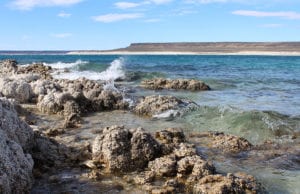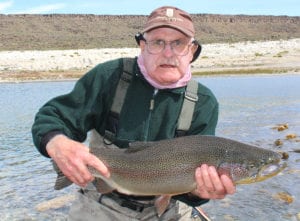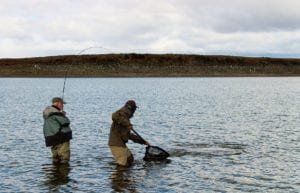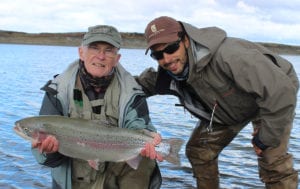- Joined
- Feb 26, 2009
- Messages
- 277,087
- Reaction score
- 8
TROUT AT ALTITUDE, WITH ATTITUDE – Rod Sturdy.
Without a doubt, I am developing a taste for wilderness fishing. There is a massive attraction in being able to reach what we in our overcrowded UK would term the middle of nowhere and enjoy a chunk of relative solitude, disturbed only by the capture of fish and occasional sightings of interesting wildlife. Not to mention the occasional social glass of Malbec…
So when I found out about the fishing offered by one of the leading lodges in South America in remote Patagonia, I was excited and booked a guided trip through Peter Cockwill. You can find out more of exactly what is on offer here: Estancia Laguna Verde, Strobel Lake, Jurassic Lake
Patagonia is a landscape manifestly shaped by volcanic activity, glaciation and tectonic shifts, a huge land mass, 90% of which belongs to Argentina and 10% to neighbouring Chile. Wildlife is sparse in this relatively harsh terrain. Such plants as are found there are hardy and nestle among the rocks and stones which are everywhere in the sparse ground. Guanacos are to be seen fairly often in small groups; they are well adapted to survival in this terrain.
No photographs can possibly do proper justice to a landscape like this. Getting to the destination involved a journey by minibus, then by truck when the terrain became rougher, of around five hours. So plenty of opportunity to take in the landscape!
The contrast with Argentina, a huge country with a population of only 14.4 per square km, makes the UK look like the overcrowded island it is with 275 inhabitants per square kilometre, or almost 400 per square kilometre if we take England alone. Patagonia however, with its total population of something under 2 m, has a population density of a piffling 1.9 per square km!
The mighty Lake Strobel aka ‘Jurassic Lake’, 30 km long and over 2,000 feet above sea level, crystal-clear with a colour I would describe as deep turquoise, situated in Santa Cruz Province, is widely known in the angling world for its legendary, hard-fighting rainbow trout, originally an introduction from North America, but now ‘naturalised’ and for practical purposes wild. And the area is also noted for the high winds from the Andes which can turn this big lake into something resembling the North Sea in stormy conditions.
Lake Strobel is crammed full of daphnia and freshwater shrimp, but only these, for rainbows to feed on, and the Barrancoso River is on hand for successful spawning.

Tasmania Bay, Lake Strobel, on a relatively calm day
Once seen, this place is never forgotten…and once experienced, the same applies to its wild rainbows. My best day on Strobel produced a modest total of two double figure fish and two smaller ones, all caught on a large dry fly. Believe me, the sight of a large dark shape approaching the fly slowly and deliberately, and then gently sucking it in, is an experience long-remembered. And their bright appearance once out of the water is really something else again.
The way these fish fight is unbelievable. To say that they are ferocious fighters is something of an understatement. On being hooked, their hitherto deliberate, placid behaviour instantly morphs into high-speed, turbocharged, and at time hair-raising runs, with all the usual rainbow aerobatics.

Yours truly with a good rainbow form Strobel’s Baya del Mar (‘Sea Bay’)
One thing this trip definitely was not about was catching a load of fish. Everyone concerned had to work hard during that week, but success was all the more enjoyable for that. Moving from the lodge and to various positions and venues across the rough terrain was all done by four-wheel truck, with two anglers and their gear, and with their guide, of course, driving.
In the vicinity of Strobel there are also a good many smaller lakes with rainbows in them, mostly with easier access than Strobel, which can all be fished. Again, the main food source is shrimp.
To see rainbows in these lakes feeding, you would sometimes think they could be carp or tench, the way they forage slowly and systematically. This is particularly noticeable in the smaller lakes: fish can be seen head down, tail up, rooting systematically for shrimp through bottom weed and algae, or moving through areas where the marginal wave action has dislodged food.
So the general message is that these fish simply do not have to chase any fast moving prey, hence flies and lures need to be fished through slowly and steadily. Bigger lures (woolly bug*er and so on) work well when the wave action is churning the lake, and smaller nymphs etc when it calms off.

Dave Hussey brings a fine rainbow to the net on Potrero (‘Paddock’) Lake
It is gratifying to be able to tie a fly with a specific venue in mind which is seven thousand miles away, then to take it there and catch fish. But that is exactly what I think I managed. The fly in question is what I call a ‘scaled-down’ dog nobbler: the usual generous, mobile spray of marabou tied onto a short-shank, forged carp hook, a 6 or 8 would be about right, with a bit of flash added round the body; and of course the key feature – two or three turns (no more) of finest lead wire behind the eye. This gives just enough undulating action with a slow retrieve to add attraction. If this lure does not float on the surface when still dry, you have either not used enough marabou, or used too much lead!
This pattern can be fished through on a floating line at a reasonable depth at virtually a snail’s pace, essential to catch these fish. There is nothing in the lake occurring naturally which this lure could possibly imitate. It is rather that this type of lure, in black particularly, seems to have a universal appeal to rainbows.
And by the way, just to point out the obvious: flies for these fish need to be tied on heavy-duty hooks – salmon or carp grade hooks only. The general aim – and this applies to lures and nymphs in equal measure – should be to produce a fly on a hook with a wide gape which will then stand well proud of the body. Natural food items in these lakes are very small and so nymphs need to be scaled down a bit (10-15 mm in length) but tied on strong, short-shank hook patterns, say a size 8.

Dave with a double-figure rainbow and guide Nahuel
Leaders likewise allow little or no compromise. The recommended strength is 15lb test all through. This is to cope with the strength of the fish, and also the fact that Lake Strobel is everywhere strewn with underwater rock features, some of which have edges which can abrade nylon mono like a serrated bread knife. You are going to lose the odd fish like this anyway, so do not risk anything less.
As for outfits, I used a #9 with a floating shooting head cut from ST11 (about 28’, with running line and backing as normal) and also at #8 with a WF8 floater, the latter for calmer conditions and dry fly. A reel with an efficient drag is essential.
The naturally occurring range of freshwater fish is relatively un-diverse, as might be expected. Ever since the late 1890’s, there have been various attempts – some much more successful than others – to introduce to the region salmonid species, including brown and brook trout as well as Chinook salmon, which are suffering declining runs elsewhere, but are now well established and thriving in Argentina and Chile.
Successful introductions include, notably, rainbow trout (Oncorhynchus mykiss) into various lakes. The latter have clearly found a perfect niche in the mighty Lake Strobel.
Take a look here to find out about Peter Cockwill and his guided trips: http://www.petercockwill.com/guided-trips/
Rod began fishing in his local park lake at the age of twelve, and from there he graduated to chub and roach from the river Tees in North Yorkshire. He now lives in Surrey within striking distance of the river Mole, as well as the Medway and the Eden in Kent and does a lot of surface carp fishing on small waters in the area. Latterly he has enjoyed winter fishing on the Test in Hampshire. He has contributed numerous articles on various angling subjects and personalities to ‘Waterlog’ magazine, as well as many posts on environmental and political subjects in support of the work of the Angling Trust on the ‘Fishing Magic’ website (www.fishingmagic.com)
He remains a passionate angler as well as a member and promoter of the Angling Trust.
The Angling Trust deserves your support in its dealings with politicians and the media to defend and promote fishing. *Find out all about the Angling Trust and its work atwww.anglingtrust.net*or call us on 01568 620447. If you’re not already a member*DO consider joining.
Source Article...
Without a doubt, I am developing a taste for wilderness fishing. There is a massive attraction in being able to reach what we in our overcrowded UK would term the middle of nowhere and enjoy a chunk of relative solitude, disturbed only by the capture of fish and occasional sightings of interesting wildlife. Not to mention the occasional social glass of Malbec…
So when I found out about the fishing offered by one of the leading lodges in South America in remote Patagonia, I was excited and booked a guided trip through Peter Cockwill. You can find out more of exactly what is on offer here: Estancia Laguna Verde, Strobel Lake, Jurassic Lake
Patagonia is a landscape manifestly shaped by volcanic activity, glaciation and tectonic shifts, a huge land mass, 90% of which belongs to Argentina and 10% to neighbouring Chile. Wildlife is sparse in this relatively harsh terrain. Such plants as are found there are hardy and nestle among the rocks and stones which are everywhere in the sparse ground. Guanacos are to be seen fairly often in small groups; they are well adapted to survival in this terrain.
No photographs can possibly do proper justice to a landscape like this. Getting to the destination involved a journey by minibus, then by truck when the terrain became rougher, of around five hours. So plenty of opportunity to take in the landscape!
The contrast with Argentina, a huge country with a population of only 14.4 per square km, makes the UK look like the overcrowded island it is with 275 inhabitants per square kilometre, or almost 400 per square kilometre if we take England alone. Patagonia however, with its total population of something under 2 m, has a population density of a piffling 1.9 per square km!
The mighty Lake Strobel aka ‘Jurassic Lake’, 30 km long and over 2,000 feet above sea level, crystal-clear with a colour I would describe as deep turquoise, situated in Santa Cruz Province, is widely known in the angling world for its legendary, hard-fighting rainbow trout, originally an introduction from North America, but now ‘naturalised’ and for practical purposes wild. And the area is also noted for the high winds from the Andes which can turn this big lake into something resembling the North Sea in stormy conditions.
Lake Strobel is crammed full of daphnia and freshwater shrimp, but only these, for rainbows to feed on, and the Barrancoso River is on hand for successful spawning.

Tasmania Bay, Lake Strobel, on a relatively calm day
Once seen, this place is never forgotten…and once experienced, the same applies to its wild rainbows. My best day on Strobel produced a modest total of two double figure fish and two smaller ones, all caught on a large dry fly. Believe me, the sight of a large dark shape approaching the fly slowly and deliberately, and then gently sucking it in, is an experience long-remembered. And their bright appearance once out of the water is really something else again.
The way these fish fight is unbelievable. To say that they are ferocious fighters is something of an understatement. On being hooked, their hitherto deliberate, placid behaviour instantly morphs into high-speed, turbocharged, and at time hair-raising runs, with all the usual rainbow aerobatics.

Yours truly with a good rainbow form Strobel’s Baya del Mar (‘Sea Bay’)
One thing this trip definitely was not about was catching a load of fish. Everyone concerned had to work hard during that week, but success was all the more enjoyable for that. Moving from the lodge and to various positions and venues across the rough terrain was all done by four-wheel truck, with two anglers and their gear, and with their guide, of course, driving.
In the vicinity of Strobel there are also a good many smaller lakes with rainbows in them, mostly with easier access than Strobel, which can all be fished. Again, the main food source is shrimp.
To see rainbows in these lakes feeding, you would sometimes think they could be carp or tench, the way they forage slowly and systematically. This is particularly noticeable in the smaller lakes: fish can be seen head down, tail up, rooting systematically for shrimp through bottom weed and algae, or moving through areas where the marginal wave action has dislodged food.
So the general message is that these fish simply do not have to chase any fast moving prey, hence flies and lures need to be fished through slowly and steadily. Bigger lures (woolly bug*er and so on) work well when the wave action is churning the lake, and smaller nymphs etc when it calms off.

Dave Hussey brings a fine rainbow to the net on Potrero (‘Paddock’) Lake
It is gratifying to be able to tie a fly with a specific venue in mind which is seven thousand miles away, then to take it there and catch fish. But that is exactly what I think I managed. The fly in question is what I call a ‘scaled-down’ dog nobbler: the usual generous, mobile spray of marabou tied onto a short-shank, forged carp hook, a 6 or 8 would be about right, with a bit of flash added round the body; and of course the key feature – two or three turns (no more) of finest lead wire behind the eye. This gives just enough undulating action with a slow retrieve to add attraction. If this lure does not float on the surface when still dry, you have either not used enough marabou, or used too much lead!
This pattern can be fished through on a floating line at a reasonable depth at virtually a snail’s pace, essential to catch these fish. There is nothing in the lake occurring naturally which this lure could possibly imitate. It is rather that this type of lure, in black particularly, seems to have a universal appeal to rainbows.
And by the way, just to point out the obvious: flies for these fish need to be tied on heavy-duty hooks – salmon or carp grade hooks only. The general aim – and this applies to lures and nymphs in equal measure – should be to produce a fly on a hook with a wide gape which will then stand well proud of the body. Natural food items in these lakes are very small and so nymphs need to be scaled down a bit (10-15 mm in length) but tied on strong, short-shank hook patterns, say a size 8.

Dave with a double-figure rainbow and guide Nahuel
Leaders likewise allow little or no compromise. The recommended strength is 15lb test all through. This is to cope with the strength of the fish, and also the fact that Lake Strobel is everywhere strewn with underwater rock features, some of which have edges which can abrade nylon mono like a serrated bread knife. You are going to lose the odd fish like this anyway, so do not risk anything less.
As for outfits, I used a #9 with a floating shooting head cut from ST11 (about 28’, with running line and backing as normal) and also at #8 with a WF8 floater, the latter for calmer conditions and dry fly. A reel with an efficient drag is essential.
The naturally occurring range of freshwater fish is relatively un-diverse, as might be expected. Ever since the late 1890’s, there have been various attempts – some much more successful than others – to introduce to the region salmonid species, including brown and brook trout as well as Chinook salmon, which are suffering declining runs elsewhere, but are now well established and thriving in Argentina and Chile.
Successful introductions include, notably, rainbow trout (Oncorhynchus mykiss) into various lakes. The latter have clearly found a perfect niche in the mighty Lake Strobel.
Take a look here to find out about Peter Cockwill and his guided trips: http://www.petercockwill.com/guided-trips/
Rod began fishing in his local park lake at the age of twelve, and from there he graduated to chub and roach from the river Tees in North Yorkshire. He now lives in Surrey within striking distance of the river Mole, as well as the Medway and the Eden in Kent and does a lot of surface carp fishing on small waters in the area. Latterly he has enjoyed winter fishing on the Test in Hampshire. He has contributed numerous articles on various angling subjects and personalities to ‘Waterlog’ magazine, as well as many posts on environmental and political subjects in support of the work of the Angling Trust on the ‘Fishing Magic’ website (www.fishingmagic.com)
He remains a passionate angler as well as a member and promoter of the Angling Trust.
The Angling Trust deserves your support in its dealings with politicians and the media to defend and promote fishing. *Find out all about the Angling Trust and its work atwww.anglingtrust.net*or call us on 01568 620447. If you’re not already a member*DO consider joining.
Source Article...
Last edited by a moderator:
